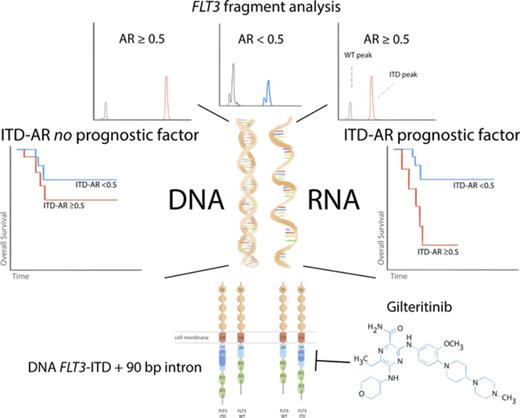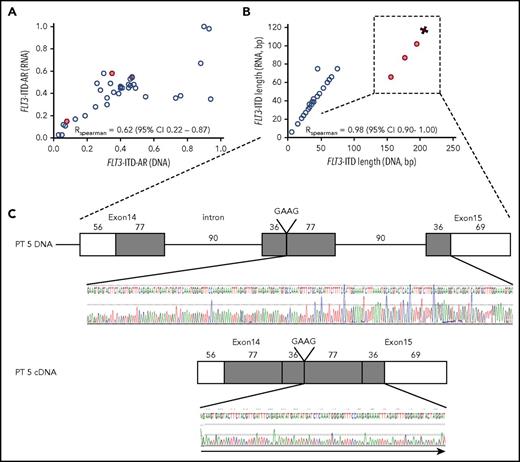Key Points
FLT3-ITD-AR measurement based on RNA, but not DNA, is predictive for survival with a cutoff point of 0.5.
FLT3-ITD-AR is associated with an ex vivo response to FLT3 inhibition with gilteritinib.
Abstract
Controversy exists whether internal tandem duplication of FMS-like tyrosine kinase 3 (FLT3-internal tandem duplication [ITD]) allelic ratio (AR) and/or length of the ITD should be taken into account for risk stratification of pediatric acute myeloid leukemia (AML) and whether it should be measured on RNA or DNA. Moreover, the ITD status may be of relevance for selecting patients eligible for FLT3 inhibitors. Here, we included 172 pediatric AML patients, of whom 36 (21%) harbored FLT3-ITD as determined on both RNA and DNA. Although there was a good correlation between both parameters ARspearman = 0.62 (95% confidence interval, 0.22-0.87) and ITDlengthspearman = 0.98 (95% confidence interval, 0.90-1.00), only AR ≥ 0.5 and length ≥48 base pairs (bps) based on RNA measurements were significantly associated with overall survival (AR: Plogrank = .008; ITDlength: Plogrank = .011). In large ITDs (>156 bp on DNA) a remarkable 90-bp difference exists between DNA and RNA, including intron 14, which is spliced out in RNA. Ex vivo exposure (n = 30) to FLT3 inhibitors, in particular to the FLT3-specific inhibitor gilteritinib, showed that colony-forming capacity was significantly more reduced in FLT3-ITD-AR ≥ 0.5 compared with ITD-AR-low and ITD− patient samples (P < .001). RNA-based FLT3-ITD measurements are recommended for risk stratification, and the relevance of AR regarding eligibility for FLT3-targeted therapy warrants further study.
Introduction
Internal tandem duplication of FMS-like tyrosine kinase type 3 (FLT3-internal tandem duplication [ITD]) is a recurrent aberration used for risk stratification in acute myeloid leukemia (AML).1-3 The length of the duplication is variable4 and may be associated with the extent of constitutive FLT3 signaling leading to increased cell proliferation.5
Using fragment length analysis, a relatively high allelic ratio (AR) has been associated with poor outcome.6-9 No consensus has been reached as to whether AR and/or the length of the ITD have a prognostic impact on outcome or whether ITD-AR analyses should be performed using DNA or RNA.
The current study (1) compares ITD measurements based on RNA and DNA, (2) establishes the role of both ITD-AR and ITD length for further risk classification, and (3) determines whether ex vivo sensitivity to selected FLT3-inhibitors depends on AR and ITD length.
Study design
Diagnostic bone marrow samples were obtained from 172 AML patients included in the Dutch-Belgian Pediatric AML Protocol for Children With Newly Diagnosed Acute Myeloid Leukaemia Based on the NOPHO-AML 2004 Study (DB-AML01)10 (n = 108) or NOPHO-DBH-AML 12 (n = 64) trial. FLT3-ITD-AR was measured on both DNA6,11 and RNA12 and correlated with both clinical outcome and sensitivity to FLT3 inhibitors (gilteritinib and midostaurin).
Results and discussion
FLT3-ITD measurements on DNA and RNA
Thirty-six (21%) patients were positive for the FLT3-ITD mutation at RNA level. One patient was positive at the DNA level only, possibly because of low expression of the FLT3-ITD gene. In 1 patient, an ITD was detected at the RNA level but repeatedly not at DNA level (supplemental Table 1, available on the Blood Web site), possibly because the very low AR (0.01) represents a minor subclone.13 ITD-AR of DNA correlated with RNA (ARspearman = 0.62; 95% confidence interval [CI], 0.22-0.87; Figure 1A). Likewise, ITD length on DNA was highly correlated with RNA (ITDlengthspearman = 0.98; 95% CI, 0.90-1.00; Figure 1B). There was no significant correlation between FLT3-ITD-AR and length (Rspearman = 0.34, P = .063).
Comparison of RNA- and DNA-based measurements of FLT3-ITD status. (A) FLT3-ITD-AR and (B) FLT3-ITD length based on RNA and DNA measurements. (C) Visualization of 90-bp intron splicing occurring in 4 samples with relatively large ITD.
Comparison of RNA- and DNA-based measurements of FLT3-ITD status. (A) FLT3-ITD-AR and (B) FLT3-ITD length based on RNA and DNA measurements. (C) Visualization of 90-bp intron splicing occurring in 4 samples with relatively large ITD.
In 4 samples, ITD length at the DNA level was approximately 90 base pairs (bps) longer than at the RNA level (supplemental Table 1). DNA and RNA sequencing of 3 of these patients revealed a 90-bp intron between exons 14 and 15 on DNA, which was spliced out and not included in RNA measurements (Figure 1C). Overall, AR was comparable using either DNA or RNA, suggesting no large differences between DNA content and subsequent gene expression, which is in line with recently published data.9
Significance of FLT3-ITD-AR and ITD length for risk classification
Survival analysis was performed only on data of patients from the DB-AML01 protocol because of sufficient follow-up time (supplemental Tables 2 and 3). Within the group of FLT3-ITD patients, gender, age, blast percentage, FAB classification, complex karyotype rates, and number of NPM1 and FLT3-TKD mutations (supplemental Table 3) were similar among FLT3-ITD-low and high AR patient groups (data not shown).
FLT3-ITD patients had significantly lower event-free survival (EFS) than FLT3-ITD-wild-type (WT) patients (Plogrank < .001; supplemental Figure 1A). The difference in overall survival (OS) between FLT3-ITD and FLT3-WT AML patients was borderline significant (Plogrank = .066; supplemental Figure 1A).
Using received operating characteristic analysis, the optimal cutoff point for prediction of death (at the end of the follow-up time and after 1 year) was an ITD-AR of 0.5. In patients with FLT3-ITD-AR ≥ 0.5 as measured on RNA, OS was significantly shorter compared with FLT3-ITD-AR < 0.5 (Plogrank = .008; Figure 2A) and compared with FLT3-WT patients (Plogrank < .001). Patients with FLT3-ITD-AR < 0.5 and FLT3-WT patients had similar OS (Plogrank = 1). EFS and relapse-free survival in patients with FLT3-ITD-AR ≥ 0.5 compared with FLT3-ITD-AR < 0.5 were not significantly different (Figure 2B; supplemental Figure 1C). Patients with both high and low ITD-AR (on RNA) had significantly worse EFS compared with FLT3-WT (Plogrank = .016 and Plogrank = .008, respectively; Figure 2B). Based on DNA measurements, no cutoff level could show a significant association with survival (Figures 2C-D).
Effect of FLT3-ITD-AR and length on survival of pediatric AML patients treated in the DB-AML01 protocol and clonogenic capacity in vitro upon treatment with gilteritinib and midostaurin. (A) OS and (B) EFS according to FLT3-ITD allelic ratio based on RNA measurements. (C) OS and (D) EFS according to FLT3-ITD allelic ratio based on DNA measurements. Effect of FLT3-ITD length on (E) EFS and on (F) OS based on RNA measurements. All reported P values compare groups within FLT3-ITD+ patients. Clonogenic capacity of primary bone marrow samples upon treatment with (G) gilteritinib and (H) midostaurin. Data were normalized to the mean of the clonogenic capacity of untreated samples. At the concentration of 1 µM gilteritinib, only normal bone marrow was used.
Effect of FLT3-ITD-AR and length on survival of pediatric AML patients treated in the DB-AML01 protocol and clonogenic capacity in vitro upon treatment with gilteritinib and midostaurin. (A) OS and (B) EFS according to FLT3-ITD allelic ratio based on RNA measurements. (C) OS and (D) EFS according to FLT3-ITD allelic ratio based on DNA measurements. Effect of FLT3-ITD length on (E) EFS and on (F) OS based on RNA measurements. All reported P values compare groups within FLT3-ITD+ patients. Clonogenic capacity of primary bone marrow samples upon treatment with (G) gilteritinib and (H) midostaurin. Data were normalized to the mean of the clonogenic capacity of untreated samples. At the concentration of 1 µM gilteritinib, only normal bone marrow was used.
Except for 3 patients, all FLT3-ITD+ patients received allogeneic stem cell transplantation. Without these patients, the survival analysis remained similar, suggesting that FLT3-ITD-WT and FLT3-ITD-low AR patients are more successfully salvageable and high AR patients would benefit from therapy able to reduce the burden of FLT3-ITD+ cells.
ITD length has been related to the extent of autophosphorylation, which negatively affects OS because of a growth advantage,14 whereas others report no significant relation between ITD length and outcome.9,15,16 Based on our data, ITD length ≥48 bp was associated with shorter OS compared with FLT3-ITD patients having an ITD length <48 bp (Plogrank = .029; Figure 2E). EFS and relapse-free survival were both statistically different between patients with relatively long and short ITD (Figure 2F; supplemental Figure 1D). The number of patients harboring FLT3-ITD did not allow multivariate analysis. However, using Cox regression, it could be shown that −2log likelihood of FLT3-ITD-AR is slightly better than length itself and that adding the latter parameter to the model did not significantly improve the model (PLR = .078). Hence, AR is the most significant prognostic parameter, but, interestingly, ITD length has relevance as well in this study and should be investigated in more detail.
Ten patients had a single NPM1 mutation, whereas 6 patients had mutations in both NPM1 and FLT3-ITD. The effect of NPM1 mutations on the prognostic significance of FLT3-ITD-AR ≥ 0.5 could not be determined because there was only 1 patient with both a FLT3-ITD-AR ≥ 0.5 and mutated NPM1 (supplemental Table 2).
Effect of ITD-AR on response to tyrosine kinase inhibitors
FLT3-ITD is a prognostically relevant molecular aberration.8,11,17,18 Tyrosine kinase inhibitors are being investigated in clinical trials, with varying results,19-22 but the literature is inconclusive about the effect of AR on FLT3-inhibitor sensitivity.23,24 Exposure of primary AML samples to 0.05 µM gilteritinib resulted in significantly decreased clonogenic capacity of FLT3-ITD-AR ≥ 0.5 samples compared with FLT3-WT and FLT3-ITD-AR < 0.5 samples (Figure 1G). This effect was present to a lesser extent in specimens treated with midostaurin, possibly explained by aspecific binding of multiple kinases with suboptimal inhibition of FLT3 by midostaurin, whereas gilteritinib specifically and potently targets FLT3 (Figure 1H). At higher dosages, the nonsignificant differences can be explained by more off-target effects and the cell numbers becoming too low. Moreover, 5 patients with relatively low AR (0.29-0.48) were analyzed according to ITD length, and long ITD responded significantly better to gilteritinib, suggesting that ITD length is also relevant for response to FLT3 inhibition in patients with low FLT3-ITD-AR, whereas in patients with high FLT3-ITD-AR, the ITD length had less effect on response (supplemental Figure 2).
Our data indicate that FLT3-ITD-AR is associated with survival in pediatric AML, which is essential for risk assessment. Although DNA and RNA measurements show good concordance, the FLT3-ITD-AR on RNA is recommended because of superior prognostic value and accurate messenger RNA length measurement. In addition, FLT3-ITD-AR might be a potential marker for selecting patients for treatment with tyrosine kinase inhibitors but should be investigated more thoroughly. Moreover, our findings suggest the relevance of ITD length in both outcome and response to FLT3 inhibitors, which warrants further research.
The online version of this article contains a data supplement.
The publication costs of this article were defrayed in part by page charge payment. Therefore, and solely to indicate this fact, this article is hereby marked “advertisement” in accordance with 18 USC section 1734.
Acknowledgment
This work was supported by a grant from the Egbers Foundation.
Authorship
Contribution: D.G.J.C., B.D., J.P., G.J.S., J.C., and E.S. designed the study and performed experiments; B.I.L.-W. assisted in statistical analysis and reviewed the manuscript; G.J.L.K., V.d.H., J.J.W.M.J., S.Z., G.J.O., C.M.Z., M.M.v.d.H.-E., B.d.M., F.V., K.V. and E.S.J.M.d.B. provided clinical samples and data and reviewed the manuscript; Z.K. and T.C. performed experiments; and D.G.J.C. and J.C. wrote the manuscript.
Conflict-of-interest disclosure: The authors declare no competing financial interests.
Correspondence: Jacqueline Cloos, Pediatric Oncology/Hematology and Hematology, VU University Medical Center, De Boelelaan 1118, 1081 HV Amsterdam, The Netherlands; e-mail: j.cloos@vumc.nl.
References
Author notes
E.S. and J.C. contributed equally to this study.




This feature is available to Subscribers Only
Sign In or Create an Account Close Modal